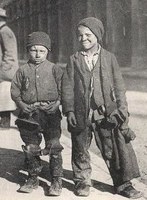- Farmers – from low risk to high risk
-
Farmers like Finland Swede Johan Eklund, used to be part of the group of occupations which carried a low risk of occupational disease. But changing sun habits, foreign holidays and tanning salons makes the total exposure so high that measures are needed. Johan Eklund (above) works the fields of Brutuby, Vanda. He lives in Sibbo
- Unbearably long time from diagnosis to treatment
-
 In 1775 the English surgeon Percival Pott wrote a report on several cases of cancer which he had discovered on a London chimney sweep’s testicles. At the time, child chimney sweeps were not uncommon, because they were small and could be lowered into the chimneys. As a result, they spent the years from childhood to old age working in an environment filled with soot, tar and burned coal.
In 1775 the English surgeon Percival Pott wrote a report on several cases of cancer which he had discovered on a London chimney sweep’s testicles. At the time, child chimney sweeps were not uncommon, because they were small and could be lowered into the chimneys. As a result, they spent the years from childhood to old age working in an environment filled with soot, tar and burned coal.
For more than 250 years we have therefore known of the carcinogenic substances present in many working environments. But moving from that knowledge to actually doing something to reduce the risk has often been unbearably long.
As early as in 1870 it was known that many miners in Central Europe were dying from lung cancer. It took 50 years to discover that radioactive dust was the cause. Still,100 years later thousands of American workers continued to work in uranium mines which tripled their risk of developing lung cancer.
At the beginning of the new millennium researchers discovered aromatic amines in colourants used in the textile industry, which led to bladder cancer. In the 1970s, people still worked in industries where they were exposed to substances like benzidine and beta-naphthylamine – in one benzidine factory half of all the employees developed cancer.
50 years ago asbestos was found to not only cause lung diseases, but also lung cancer. But until the mid-1970s, there were dozens of asbestos factories and hundreds of companies using asbestos – in some factories the dust was so thick it stopped light from getting through. 30 to 40 percent of all those who worked with asbestos are thought to have developed lung cancer.
Source: Wikipedia, Cancer and the Worker, red B. Boland and P. Lehman. Painting: Frans Wilhelm Odelmark
 Follow us on Facebook
Follow us on Facebook
